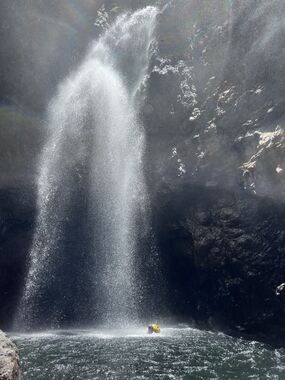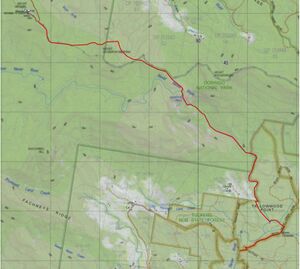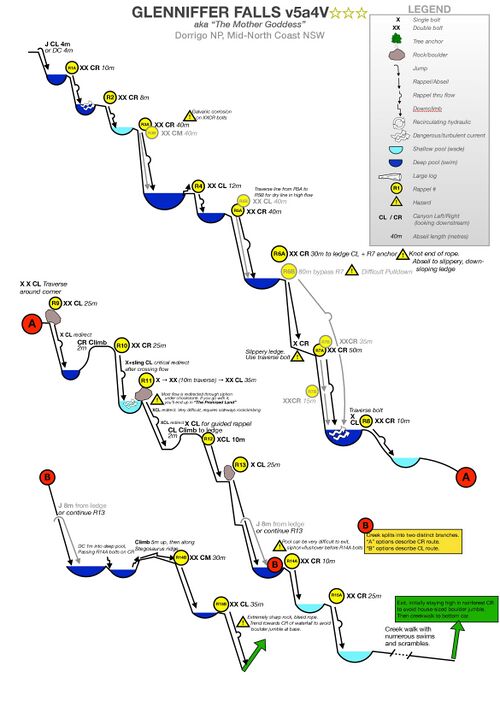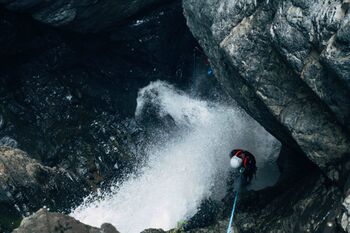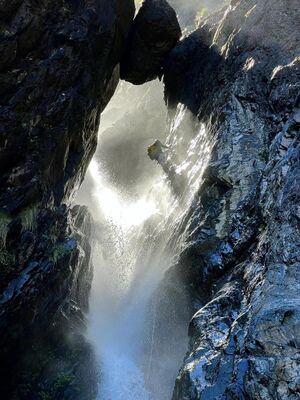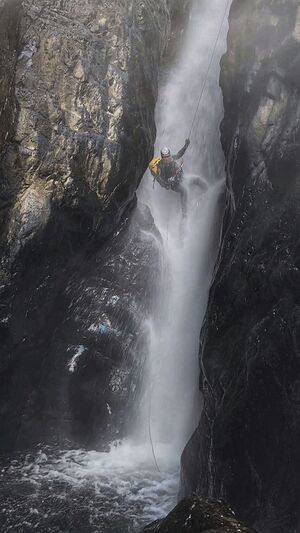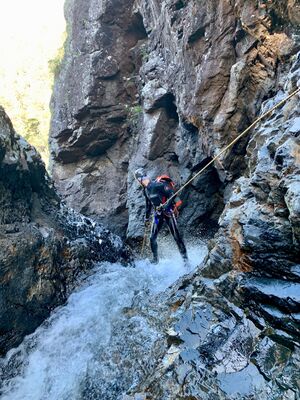Gleniffer Canyon
| Rating: | |||||||||||||||||||||||||||||||
|---|---|---|---|---|---|---|---|---|---|---|---|---|---|---|---|---|---|---|---|---|---|---|---|---|---|---|---|---|---|---|---|
| | Raps:15, max ↨230ft
Red Tape: Shuttle:Required | ||||||||||||||||||||||||||||||
| Start: | |||||||||||||||||||||||||||||||
| Parking: | |||||||||||||||||||||||||||||||
| Shuttle: | |||||||||||||||||||||||||||||||
| Condition Reports: | 25 Oct 2025
"All anchors were there and in condition, except couldn’t find R10 traverse bolt, so placed a new bolt river left, up a 2m climb. |
||||||||||||||||||||||||||||||
| Best season: | When river is low
|
||||||||||||||||||||||||||||||
| Regions: | |||||||||||||||||||||||||||||||
Introduction[edit]
Glennifer is one of the top canyons in Australia. It is technically challenging and spectacular.
The canyon is highly technical with hanging anchors, multipoint traverse lines and redirects across flow. It require competence and experience with contemporary single rope canyoning techniques. The ropework is demanding. All party members must have experience and are comfortable in v5a4 to v6a5.
There are no exits. Any external rescue will take many, many hours.
Parties should be ready to replace bolts, and re-equip redirects.
Water level[edit]
205019 Never Never at Old Crossing - WaterNSW WaterInsights
- <15 ML/d: v5a4 low water volume
- >15 ML/d - <100 ML/d: v5a4 high water volume
- 100 - 150: v6a5
- >150 = Stay home
Highest known descent is 150 ML.
See the trip reports section for the river at various heights.
The catchment is 18 km² in a high rainfall area which floods regularly. The river can flash-flood. The sheer volume of water that can flow through this canyon necessitates that you take a drill and bolts in case exisiting anchors have been damaged (and they have in the past!)
Historical notable flow rate (non-comprehensive):
- ~33,700 ML/d recorded on 18 March 2017
- ~26,800 ML/d recorded on 15 January 2024
- ~22,700 ML/d recorded on 7 March 2025
The 205019 Never Never at Old Crossing river gauge is located at -30.38407, 152.89031 approximately 9km downstream of Gleniffer Canyon. It is considered a very good proxy gauge for water conditions in Gleniffer.
Approach[edit]
A car shuffle is required. Consider placing the bottom car the night before to optimise your time on the canyoning day. Park the bottom car at Never Never River on Promised Land Road. If you have a 4wd, drive up Tallowwood Road as far as you can - this will make for a slightly shorter walk out.
Then do the long drive up to Mount Moombil and park the top car.
Walk-in: Follow the GPX down the ridge from Mount Moombil, skirt northwards around Mount Goobergooberyam (there is an unmarked logging track here), eventually going down the ridge to the Never Never river. Arrive pretty much to come out just above the falls - nice big rock on CL where you can get changed.
Descent[edit]
The abseil table below is authoritative.
| Rap | M | L/R | Description |
|---|---|---|---|
| 5 | CL | Jump into pool with log - bit of a flush over in high water | |
| R1 | CL (higher flow) or CR | ||
| R1a | 10m | CR | Double bolt anchor. Abseil goes through flow |
| R1b | 10m | CL | Single bolt |
| R1c | 10m | CL | Jump where single bolt is |
| Pool at the bottom flushes over on the left, there is an eddy on CR to swim into and climb out | |||
| R2 | 10m | CR | Double bolt |
| R3 | Double waterfall with two arms | ||
| R3a | 40m | CR | Double bolt anchor. Abseil goes through flow. Bolts are slightly dodgy (galvanic corrosion) |
| R3b | 40m | CC | Canyon centre on the floor. Abseil goes down dry wall in between two waterfalls |
| Abseil down into big pool and swim across | |||
| R4 | 20m | CL | Double bolt anchor. Climb out from end of R3 pool on CL onto a high ledge to get to anchor. Abseil puts you in the flow at the bottom - bit dicey. Big jump (15m) is possible over rocks - jump out far – have to abseil a few metres down to the jump point. Big swim across pool from bottom of R4 to top of R5. |
| R5 | Money pitch! | ||
| R5a | 40m | CR | Double bolt anchor. Abseil puts you in full flow |
| R5b | 40m | CL | Second option for higher flow: use the R5a anchor to set a traverse line to take you to R5b - 40m - CL wall - double bolted anchor - out of the flow |
| CR | At the bottom of R5, swim across pool and get out CR using a ledge | ||
| R6 | 30m | CR | Double bolt anchor CR - use this to set a traverse line over the edge to another double bolt anchor which you can use for R6. Should do traverse as rock is sharp so it sets better angle over edge. Abseil down to ledge on CR |
| R7 | CR | Single bolt anchor CR right where you finish R6 - use this to set traverse line out right to double bolted anchor to use for abseil. There are two options as to where you can abseil to from this anchor | |
| R7a | 50m? | CR | Only possible in low water - abseil all the way to the bottom through the flow |
| R7b.1 | 35m | CR | Abseil down along rocks on CR all the way to next anchor (set of bolts on boulder). Do not get off rope early and then scramble down rocks - it is very difficult / impossible to get to next anchor if you are not on rope. |
| R7b.2 | 15m | CL | Abseil down to creek and jump across flow to CL to next anchor. It is also possible to abseil all the way down (25m) to R9 anchor (skip R8) and cross the creek while abseiling |
| R8 | 10m | CL | Single bolt |
| R9 | 25m | CL | Single bolt anchor CL - use that to set traverse line out around corner and there is a double bolt anchor for R9. Abseil goes from chockstone down into nice slot - can get pretty pumpy. There is a redirect out far left past the anchor you can use in high flow (first person should set retrievable redirect) |
| R10 | 25m | CR | Double bolt. Old carabiner stuck on anchor - make sure you don’t clip into it. Abseil includes a fixed redirect on CL with a permanent sling and carabiner - this redirect is absolutely essential! Good idea to tie a knot in the end of the rope in case someone doesn’t make the redirect. You land in a small pool, bit tricky to get out. |
| R11 | CL | Single bolt CL - use this to set traverse, there are two more sets of bolts (one to re-thread the rope through as part of traverse line and then second double bolt is the anchor). There are two options for where to abseil to: | |
| R11a | 35m | CL | Exit on CL on a big ledge. If you don’t use redirect bolts, you have to do a small climb in the corner to get up onto the ledge. On this ledge there is a single bolt you can use to set a guided rappel if necessary. (Go to R12) |
| R11b | 70m | CL | Full pitch the whole way down in full flow. If you do this full pitch, you skip R12 and R13. Near the top of the pitch there are two separate bolts for two re-directs - these help you get out of the flow and onto the ledge. It is a proper sideways rock climb to get to them - bit dodgy - so better not to use them unless you have to |
| R12 | 10m | CL. | From single bolt on big ledge (guided rappel bolt from R11). Abseil leftwards down ledge to next anchor. Abseil may not be necessary - could just scramble down to next set of bolts |
| R13 | 30m | CL | Single bolt. Can jump into pool from ledge part way down but it’s pretty dodgy. Pool at the bottom is difficult to exit in high flow - exit on CR and then cross the creek, don’t get flushed over. |
| R14/15 | Creek splits into two branches - two options (a or b) for how to get down | ||
| R14a | 10m | CR | Double bolts. Difficult to get to anchor in high flow - have to jump into pool on left and then swim / bridge across flow to get to anchor |
| R15a | 25m | CR | Double bolts. Abseil all the way to rocks at the bottom of waterfall |
| R14b | 30m | CC | Scooch along rock ridge on butt, out to double bolted chain anchor. |
| R15b | 35m | CL. | Drop is very sharp - bleed rope. Stay right of the waterfall - descend down to boulders |
Exit[edit]
End of abseils, now we have slow boulder creek walking. Good idea to stick to edge of rainforest on CR until the creek gets a bit flatter - means that you avoid the boulder hopping. About 500m before Howards Road meets the creek there is a path on CR of the river (may have to go up through trees a bit to get to it) - follow this path, then go up Howards Road and along Tallowwood Road to car.
Red tape[edit]
Beta sites[edit]
Trip reports and media[edit]
(Click through the picture)
UNSW Outdoor Club 2 Feb 2020, 28 ML, "semi sporty".
Glenniffer at 55 ML (Facebook link), "Good water level for never having done the canyon, did most of the full flow anchors, didn't need any of the redirect bolts"
Glenniffer at 150 ML (Facebook link), "Highest known descent yet"
Gleniffer Canyon at 35 ML
Gleniffer Canyon at 15.5 ML
Re-opening Descent[edit]
Mitchell Stewart - March 29 2019
Ryan Hunter, Alex O'Connor Mason and myself made a full descent of Gleniffer Falls canyon on Wednesday the 20th of February, 2019. This canyon is intimidating and steep and features some of the best waterfall abseils in Australia. This trip is one of the top three outdoor experiences I've ever had in Australia. The slot in the lower part of the falls terrifying yet spectacular!! We saw almost no evidence of previous descents, indicating that the waterway has the potential to pick up large amounts of rock and log debris destroying any anchor systems put in place. This was evident by the large logs that were seen high up on a ledge in the first large pool system. Our party has been canyoning in many countries around the world and we are very experienced in high flow canyons. We recognised many signs of what this canyon is capable of in the wrong (wet...) conditions. It is not recommended to enter this canyon before, during, or after rain and without the ability to replace bolted anchors (hammer drill and bolting kit is required).
After the 3rd abseil... you are totally committed to the descent, so be aware that there are no escape routes and you must be confident in your experience and ability to commit to a full descent. 80m ropes are ESSENTIAL and we recommend taking three ropes... be WELL prepared for an overnight stay with space blankets and food. Btw utmost respect to Dicky Baker, Andy Robb, Brian Cork, and Dan for their efforts involved with this tremendous canyon.
Background[edit]
First descent in 1994
